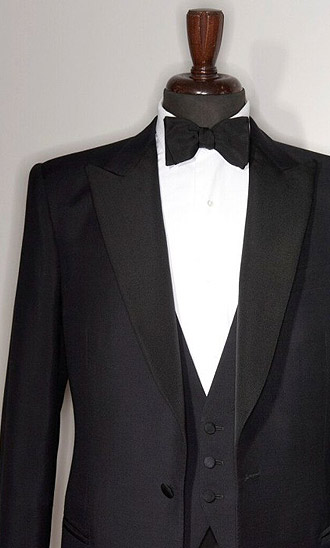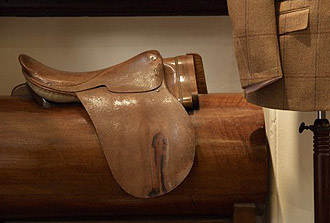1901: Welsh & Jeffries opens a bespoke tailoring shop on Eton High Street where the firm specialises in making uniforms for Eton College, England’s most prestigious public school.
1902: Henry Poole is the largest establishment on Savile Row employing 300 tailors, 14 cutters and making 12,000 bespoke garments per year. Bertie is crowned King Edward VII and adds his Royal Warrant to a collection that now includes The Crown Prince of Prussia, The King of The Belgians, The Khedive of Egypt, Tsar Alexander II of Russia, King Umberto I of Italy and The Emperor of Mexico.
1912: No 1 Savile Row is purchased from the Royal Geographical Society – where H.M Stanley and Dr. David Livingstone both lectured – by Hawkes & Co for the sum of £38,000 and another £10,000 is spent on converting the premises to suit Hawkes’s business. Hawkes is appointed to dress the Honourable Corps of Gentlemen at Arms, the British Monarch’s nearest bodyguard.
1913: Sidney Horatio Sheppard invests £2000 in Anderson & Simmons (founded 1906) and the firm Anderson & Sheppard is born at No 13 Savile Row.
1917: In the year of the Russian revolution, Welsh & Jeffries acquire a property at the heart of fashionable St James’s at No 15 Duke Street. The firm makes uniforms for officers of many regiments including The Coldstream Guards and boasts that it has more British Army Generals on its books than any other in Mayfair. Many of them fail to survive the Great War.
1918: World War I fighter pilot Baron Manfred von Richthofen (the Red Baron), a dedicated customer of Norton & Sons, is shot down in action and killed.
1919: H. Huntsman & Sons occupies its present address at No 11 Savile Row.
1921: Crown Prince Hirohito of Japan commissions Henry Poole & Co to create westernised suits for his state tour of Britain. A representative of Poole’s sails to Gibraltar with pattern templates where he meets The Crown Prince’s destroyer and cables measurements to London so the order can be accomplished before the Prince reaches the UK in three weeks time.
1922: Resplendent in Norton & Sons tweeds, philanthropist and bounty hunter Lord Carnarvon and archaeologist Howard Carter discover the tomb of Tutankhamun in the Valley of the Kings, Egypt.
1923: The Duke of York (future King George VI) marries Elizabeth Bowes-Lyon (future Queen Elizabeth The Queen Mother). King George V, the Prince of Wales and the Dukes of York, Gloucester and Kent all wear uniforms tailored by Gieves. So too does H.R.H. The Duke of Edinburgh when he marries Princess Elizabeth in 1947.
1925: It’s the Jazz Age and Kilgour & French employ two Hungarian immigrant tailors, Fred and Louis Stanbury, who become legends on Savile Row and firm favourites with Hollywood royalty. In 1934 the Stanbury brothers create Fred Astaire’s iconic white tie and tails as worn in the Astaire & Ginger Rogers film Top Hat. By 1937 the firm is rechristened Kilgour, French & Stanbury.
1926: Silent Screen idol Rudolph Valentino dies. As the first Hollywood matinee idol on the tailoring house books, Valentino’s tragic yet glamorous aura (not to mention the memory of his immaculate suits) attracts Douglas Fairbanks Sr, Marlene Dietrich, Noel Coward and Gary Cooper to Anderson & Sheppard.
1930: Mayfair’s premier bespoke tailoring houses Henry Poole & Co, H. Huntsman & Co, Anderson & Sheppard, Welsh & Jeffries and Davies & Son enjoy the bounty of India’s Anglophile Maharajahs of Alwar, Baroda, Gwalior, Jaipur, Jodhpur and Cooch Behar who illuminate 30s London’s high society. Henry Poole & Co is awarded The Maharajah of Baroda’s Royal Warrant in 1905, but the dazzling Jitendra Narayan, Maharajah of Cooch Behar (married to one of the era’s great beauties, Indira of Baroda) becomes Poole’s most dazzling and prolific customer. ‘Jit’ Cooch Behar is reputed to have had over 1,000 bespoke suits and uniforms made by the firm.
1932: Family business Hunstman comes under the ownership of the exacting Robert Packer who insists that all garments are cut and sewn in house and not by outworkers.
1939: On the eve of World War II, King George VI suspends the ceremony of holding court in the Royal drawing rooms where unmarried, aristocratic ‘debutantes’ were presented to the sovereign. Queen Elizabeth II would go on to abolish the ceremony entirely. Henry Poole’s father James had modernised court dress by the order of Queen Victoria in 1869 from frilly Georgian lace jabot and cuff to a cleaner white tie and winged collar shirt worn with black velvet breeches and tails. In the year of The Wizard of Oz, Gone With The Wind and Now Voyager, Hollywood’s most powerful mogul MGM boss Louis B. Meyer chooses Kilgour, French & Stanbury as his Savile Row tailor of choice. Where Meyer leads, Edward G. Robinson, Rex Harrison, Cary Grant, David Niven, Frank Sinatra and Ava Gardner follow.
1940: Gieves is approached by Charles Frazer-Smith (a character not dissimilar to Q in Ian Fleming’s James Bond books) to develop compass buttons, cavity buttons (concealing explosives, poison pellets and maps printed on silk) and Gili saws (serrated wire on a ring pull concealed in a cap badge) for British espionage agents on active service in Germany and occupied France.
1942: Colin Hammick joins Huntsman as a fifteen year old apprentice. He goes on to rise to the rank of the Head Cutter in the 50s and is largely responsible for pioneering the cut and style that is synonymous with Huntsman today.
1945: Hardy Amies, the first post-war haute couturier in London, restores the derelict husk of a Regency house at No 14 Savile Row that had suffered a direct hit in the Blitz and opens his doors for business.




